
About Andrew Cusack
 Writer, web designer, etc.; born in New York; educated in Argentina, Scotland, and South Africa; now based in London.
Writer, web designer, etc.; born in New York; educated in Argentina, Scotland, and South Africa; now based in London. read more
News
Blogs
Reviews & Periodicals
Arts & Design
World
France
Mitteleuropa
Knickerbockers
Argentina
The Levant
Africa
Cape of Good Hope
Netherlands
Scandinavia
Québec
India
Muscovy
Germany
Academica
A Good Day in Cape Town
The South African Royal Family’s 1947 visit to “Die Moederstad”
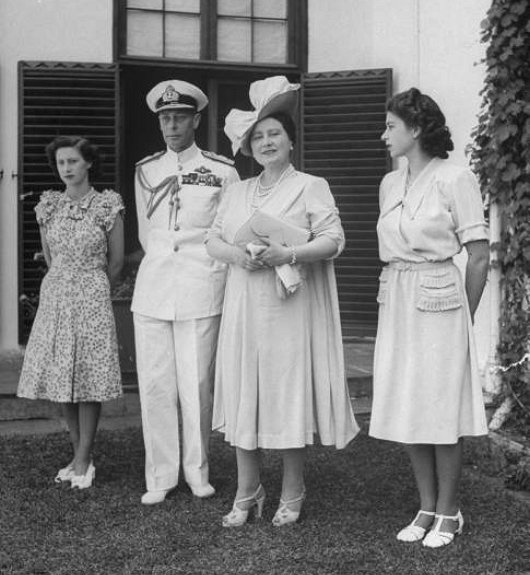
SOUTH AFRICA IS a nation that took a long time birthing, from the first steps van Riebeeck took on the sands of Table Bay in 1652, through the tumult of the native wars, the tremendous conflict between Briton & Boer, and ultimately what was hoped would be the final reconciliation in Union of South Africa — 1910. In that year, young Prince Albert of York & of Saxe-Coburg-Gotha was just fifteen years of age, and South Africa became a dominion just weeks after his father became King George V.
Albert was the second son of a second son, so at the time of his birth (and for most of his early life) it was never expected that he would one day be King of Great Britain, Emperor of India. It was his brother’s abdication that thrust poor Bertie, as he was always known to his loved ones, upon the throne imperial. It was a cold December day in 1936 that the heralds of the Court of St. James proclaimed him George VI.
By his nature, the King was a quiet and reserved man, partly because of the stammer that impeded his speech. George VI was happiest among his family, and they accompanied him in 1947 on a long voyage aboard HMS Vanguard, to his far-off kingdom on the other side of the world, where the two oceans meet. It was the first time a reigning monarch has set foot on South African soil, and Capetonians waited in earnest anticipation to see their sovereign. How appropriate that this happy city — moederstad, or “mother-city”, of all South Africa — would be the first to receive him.
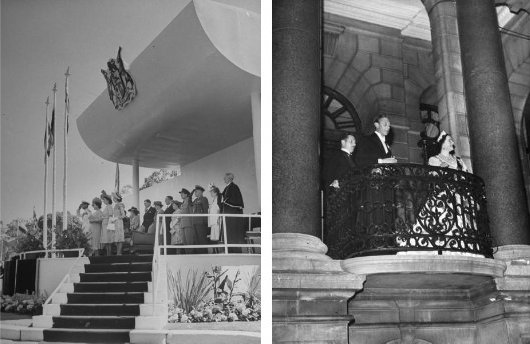
Left: At the Grand Parade. Right: Speaking to a crowd composed of every race before a ball in the City Hall.
The King & Queen of South Africa were officially welcomed at the Grand Parade, the open square on which sits the Castle of Good Hope — the oldest building in South Africa — and that gem of the Edwardian baroque, the City Hall.
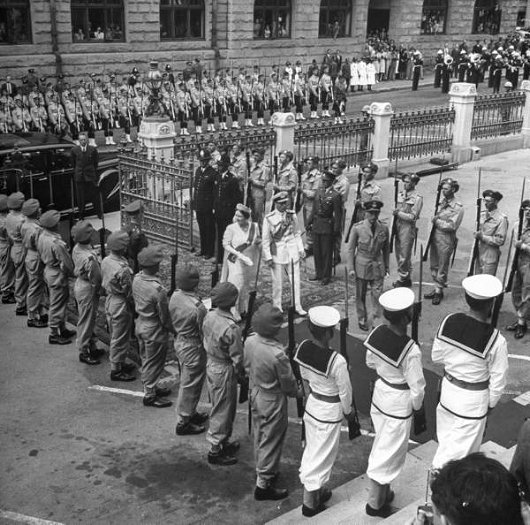
Above: The King & Queen arrive at the Houses of Parliament, Cape Town.
The constitutional highlight of the visit, however, was on a following day, when the King officially opened a session of the Parliament of South Africa. It was the first time in the history of the British Empire that the reigning sovereign opened a dominion parliament. (As King of Canada, George VI had visited his parliament in Ottawa in 1939, but only to give assent to a number of laws; not to open the parliamentary session itself).
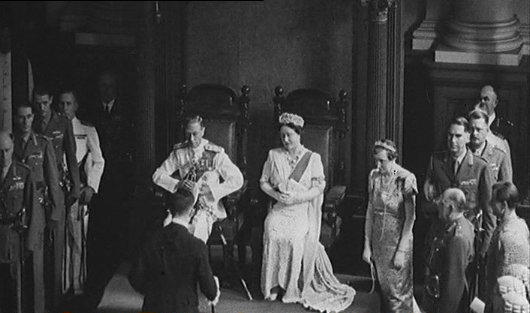
Above: The Gentleman Usher of the Black Rod (Draer van Swart Roede) bows to the King.
Seated on his throne in the Senate, the King read out a brief speech in English, before instructing Christiaan Andries van Niekerk, the gowned and be-wigged Lord President of the Senate, to read a translation of the speech in Afrikaans. Then, speaking in both English and Afrikaans, he declared the parliamentary session open.
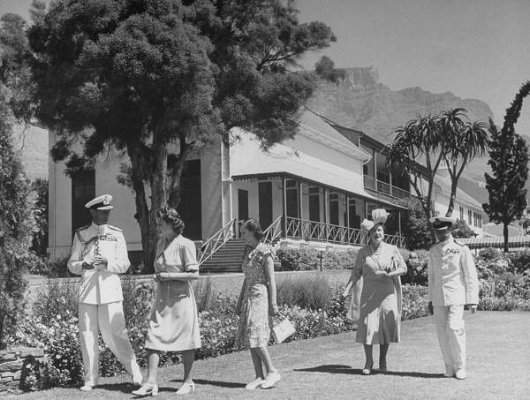
While in Cape Town, the Royal Family stayed at Government House, as the Tuynhuys was then known. The residence has since been de-Victorianised, and restored to its classical appearance. Walking with the Queen is the King’s Equerry, Group Captain Peter Townshend, who later had an infelicitous romance with Princess Margaret.

Perhaps of greatest significance was that Princess Elizabeth’s twenty-first birthday — April 21, 1947 — occurred during her stay in South Africa, a land over which she would one day be queen. The Princess took advantage of this anniversary to make the first prominent speech of her life:
I cannot do quite as they did, but through the inventions of science, I can do what was not possible for any of them. I can make my solemn act of dedication with the whole empire listening. I should like to make that dedication now.
It is very simple: I declare before you all that my whole life, whether it be long or short, shall be devoted to your service and the service of our great imperial family to which we all belong.
But I shall not have the strength to carry out this resolution alone, unless you join in it with me as I now invite you to do. I know that your support will be unfailingly given. God help me to make good my vow and God bless all of you who are willing to share in it.
The South African monarchy was not to last. In many ways, the Royal Visit of 1947 was the twilight of the old order in South Africa. Just a year later, the Nationalists were voted into power and the system of apartheid was born. The Union of South Africa survived just over fifty years before it was supplanted by the Republic — but that is a story for another day.
Elsewhere: Royal Tour of South Africa, 1947 (BBC)
Search
Instagram: @andcusack
Click here for my Instagram photos.Most Recent Posts
- Faithful Shepherd of the Falklands April 8, 2025
- Articles of Note: 8 April 2025 April 8, 2025
- Proportionality Destroys Representation April 8, 2025
- Sag Harbor Cinema March 26, 2025
- Teutonic Takeover March 10, 2025
Most Recent Comments
Book Wishlist
Monthly Archives
Categories



Even in 1947 King George VI looks quite frail.
Great read and great photos, Andrew. One minor error though. In one of the photographs you state.. “Walking with the Queen is the King’s Equerry, Group Captain Peter Townshend,(Townsend) who later had an infelicitous romance with Princess Margaret.” Whoever that middle-aged Royal Navy admiral is he is clearly not Peter Townsend. Townsend was then a young, handsome Royal Air Force officer, a highly decorated war hero and Battle of Britain ace. The uniform worn by the gentleman in the picture – the summer naval ‘icecream suit’ – and his rank – his admiral’s epaulettes – clearly shows that it ain’t Townsend. The admiral may have been the then current Flag Officer, South Atlantic-South America station based in Simonstown.
I wonder if the royal visit harmed the chances of the United Party against the republican National Party in the fateful 1948 election.
Andrew
I think you’ve made a mistake about the President of the South African senate in 1947 during the Royal visit to South Africa. You say he was Christiaan Andries van Niekerk,while in fact it was Pieter Jurie Wessels – my great-grandfather. I have the photos to prove it. Also see Wikipedia below:
Presidents of the Senate of South Africa (1910-1980) and (1994-1997)
No. Term Name
1 1910–1921 Francis William Reitz
2 1921–1929 H.C. van Heerden
3 1929–1930 R.A. Kerr
4 1930–1940 Christiaan Andries van Niekerk (1st time)
5 1940–1941 François Stephanus Malan
6 1942–1945 Philippus Arnoldus Myburgh
7 1946–1948 P.J. Wessels
8 1948–1961 Christiaan Andries van Niekerk (2nd time)
9 1961–1969 Jozua François Naudé
10 1969–1976 Johannes de Klerk
11 1976–1979 Marais Viljoen
12 1979–1980 Jimmy Kruger
– 1981–1994 office not in existence
13 1994–1997 Kobie Coetsee
I have original photo’s of this Royal Tour, in a stunning 200 page
scrap book with all original paper clippings following this tour
and more – anybody interested to make me an offer, or would like
more info, please email me
Regards
Ruani Bester
This is very interesting, I have a photo album left to me by my father Frank Vic Wessels showing this visit, P J Wessels was his grandfather. My daughter, Savanna Wessels had a history project to do and chose this subject. South African history has certainly changed though.
The nationalist Afrikaners had a song “God save the King with a bottle of paraffin and set fire on him”. The Afrikaners disliked the British monarchical system with its implied subjugation to the British Empire..
I don’t want to “stir” but would like to know whether a story which I heard from my late father (when I still was very young) holds any truth: During the Royal Tour of SA in 1947, His Majesty was attending a military parade in his honour. The Regiment Sergeant Major (RSM) (would that be the title?) who was “in control” of the Parade noticed that upon the arrival of the King, there was something “wrong” with his uniform – perhaps something as trivial as a loose button. The RSM however was very punctual and advised the King that he was “not properly dressed.” The King then left the parade ground, had the problem fixed and returned to the RSM. This might even have happened somewhere else – e.g. in GB or somewhere else in the Commonwealth. Anybody?
Dear Ruani,
I’m potentially interested in buying your scrapbook. Thanks. Paul.